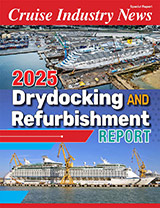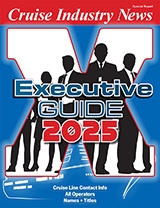The benefits and drawbacks of cruise tourism were heavily debated at last week’s Seatrade Cruise Conference, particularly by the Caribbean destinations which collectively receive approximately two-thirds of all the American cruise traffic.
Decreased Spending
Lynette Seebaran-Suite, Chairman of the Port Authority of Trinidad & Tobago, who was the only speaker on behalf of the Caribbean at the cruise conference, said that while the number of cruise passengers to the Caribbean has more than doubled since 1980, per passenger spending has decreased to an average of $73 per person per day in a Caribbean port. She attributed this to the increased on board spending opportunities on the larger, new cruise ships which may detract from spending ashore.
While cruise visitors to Caribbean ports spent around $550 million ashore in 1990, according to Seebaran-Suite, it is only 6.2 percent of the overall amount spent by tourists Caribbean-wide. Seebaran Suite pointed out that since the revenue contribution from cruise passengers is comparatively small, there are conflicting views as to the economic benefits of cruise tourism as well as fear of the effects of rapid cruise growth on the rest of the tourism infrastructure.
Funding for Growing Infrastructure
Due to the increased number of ships calling in the Caribbean as well as the larger size of many of them, the Caribbean ports have had to invest heavily in their port facilities. Seebaran-Suite pointed out that one terminal and bulkhead costs from $12 to $18 million.
While the majority of Caribbean ports charge a head tax of $2 to $4, most port officials, such as Gordon Finch, Executive Director of the U.S. Virgin Islands Port Authority said that user fees are not enough to cover new construction.
However, Finch noted that in the case of the new pier being constructed in St. Croix, passenger spending evens out the economic scale since “one band washes the other.” The problem lies in the ports which do not generate sufficient passenger spending. The U.S. Virgin Islands generate the highest passenger spending in the Caribbean, partially due to customs regulations which favor U.S. territory as well as a broad range of products and attractive prices.
Therefore, the Organization of Eastern Caribbean States (OECS) recently voted to increase passenger taxes to $10 per cruise passenger arriving in any of the eight OECS port states. This move, which will not be enacted until October 1, has caused quite a stir among cruise Line and Caribbean port executives alike. The majority of those interviewed felt that the increase will not actually take place due to the pressure felt from the industry. Sharing this view were port officials from San Juan, Barbados, U.S. Virgin Islands, and Martinique.
Frantz Thodiard, Manager of the Chamber of Commerce and Industry of Martinique, said that if the tax goes through, it could affect Martinique negatively due to the island’s proximity to a number of the OECS ports, including St. Lucia, Antigua, Grenada, and Dominica.
The Caribbean Tourism Organization will discuss the port tax later this week.
Florida Caribbean Cruise Association Seebaran-Suite called for greater cooperation between the cruise Lines and ports, whereby the gains of one party should not be made at the expense of the other.
Cruise lines are answering this call for collaboration by opening up the Florida Caribbean Cruise Association (FCCA) to associate members, including port and tourism officials, as well as port agents. The FCCA, which in the past has been composed of representatives from 13 cruise lines serving the Caribbean, is broadening its base in order to focus on common issues in the Caribbean in a more “pro-active” manner, according to Richard Sasso, Chairman of FCCA’s executive committee, and Senior Vice President of Celebrity/Fantasy Cruises. Ports and tourism officials who join will therefore be able to discuss their concerns on matters relating to legislation, port and tourism development, safety, security, and the environment.
“This gives us an opportunity to speak more frankly (with port and tourism officials) and vice versa, said Sasso.
He offered an example of how vital this group is by noting that when a port wants to expand its facilities, its officials need to talk to the cruise lines in order to see if their long-range plans co-incide with expansion.
Sasso noted that as the industry grows, there are more and more issues confronting the Caribbean ports and lines, which in turn requires more input from both sides. He said that the $10 proposed passenger tax will be an area of discussion. Sasso said that what some ports don’t realize is that if they increase their fee by $5, the cruise lines could potentially have to pay an increase at each port on the itinerary.
As for the islands’ financial return, Sasso said that cruise Lines take their own surveys on economic impact, and “we know that passengers spend money ashore. We look at cruise ships as a way of bringing quality passengers ashore and as a way for people to see an island and possibly return” for a longer stay in the future. He cited the U.S.V.I., where 25 percent of all cruise passengers return for an overnight stay.
“The FCCA is a way for us to play a bigger role in saying that we are not a threat to the Caribbean, Sasso said. He said that the group is making progress in making the industry aware that they all have common interests and goals.
Strategy
Seebaran-Suite noted that some ports have overspent in their desire to create more attractive and larger facilities, some of which has not been necessary. Part of this process includes discussing with the cruise Lines what their needs are before construction.
Charles Barnes, Marketing Manager of S.M.T.A. in St. Barts said that “some islands have to restructure their pricing policies.” He pointed out that food and drink can also be expensive on land, thereby forcing passengers to eat aboard ship.
Barnes also noted that while some islands have fairly priced stores offering diverse goods, they may not know how to deal with cruise passengers. He feels that some storekeepers and port offioals alike need to change their attitude towards cruise passengers, noting that “cruise passengers are here to stay.”
Homeports
While San Juan is the leading Caribbean homeport, a growing trend has been towards more ports vying for homeport status. Those which presently home port American-marketed cruise ships include Antigua, Aruba, Barbados, Jamaica, St. Maarten and the U.S. Virgin Islands.
Seebaran-Suite also noted that with the overcrowding in northern Caribbean ports, more southern Caribbean islands need to offer homeporting facilities and infrastructure in order to facilitate more southern Caribbean Itineraries.
According to Thodiard, once Fort-de-France’s new pier is completed in October, Martinique will be able to accommodate two large ships simultaneously. He said that Martinique is studying the possibility of becoming a homeport. By 1994/95, the island will have a new, larger airport better equipped to handle groups, as well as better services for supplying and servicing cruise ships. However, the major stumbling block is weak air connections from the U.S.
According to Jose Buitrago, Executive Director, Puerto Rico Port Authority, although San Juan was hurt by the demise of Pan Am and Eastern Airlines and the cutback of service, a number of other airlines are compensating. He noted that Braniff has begun service to San Juan, while American is using larger planes on its San Juan routes and TWA is offering more flights than before. Buitrago also said that United has been receptive to charter flights for cruise passengers, while discussions are presently underway With Northwest and Continental Airlines for possible commencement of service to this Caribbean cruise hub.
Regional Marketing
Seebaran-Suite said that co-op marketing is the trend of the future, since it allows smaller ports exposure which may not have the resources to advertise on their own. She pointed to the regional marketing organizations in Northern Europe.
Cruise Europe is a recently formed marketing organization composed of 40 member ports to promote and present concise port and tourism information to cruise line executives.
Under the direction of Mike Meyjes, Executive Manager of Cruise Europe and Sales Manager, London International Cruise Terminal in Tilbury, the group includes both larger ports such as Amsterdam, Oslo, and Tilbury, along with smaller cruise ports including Invergordon, Trondheim and Reikjavik.
According to Meyjes, the organization acts as an advisory service suggesting Northern European itineraries, as well as offering one contact point for information on numerous ports. Cruise Europe’s detailed port information is available through a computerized data system. A book on tourist attractions in each port and a newsletter are forthcoming.
Another Northern European marketing organization which has been in existence since 1983, is the Baltic Tourism Cooperation. This group is composed of 24 ports and seven national tourist boards. Dubbed the “Blue Banana” by BTC director, Arne Ellefors, the Baltic has seen steady growth particularly with the opening of Eastern Europe the past two years and the addition of ports such as Tallinn, Estonia.
The BTC is planning on setting up educational programs for retailers/travel agents in ten different countries. Also, the group offers “The Blue Book” as its resource on port facilities and sailing distances within the region.
Another region marketing itself jointly is New England and Canada, which has labelled itself the Atlantic Frontier. This group consists of 25 ports “adjacent to the heaviest traveling potential in the world, according to Walter Johnson, executive director Tourism Industry Association of Nova Scotia. In his presentation on the New Atlantic Frontier he said, “what Alaska was in the 1980s, the new Atlantic Frontier will be in the ’90s.” He cited the environmentally untouched aspects of Atlantic Canada as one of region’s many strong points.
Joint marketing, be it in Europe or in North America, is just one aspect of the overriding concern voiced by port, tourism, and cruise line executives alike – the need for co-operation between all aspects of the industry in order to continue growth and maintain a diverse, quality product.



